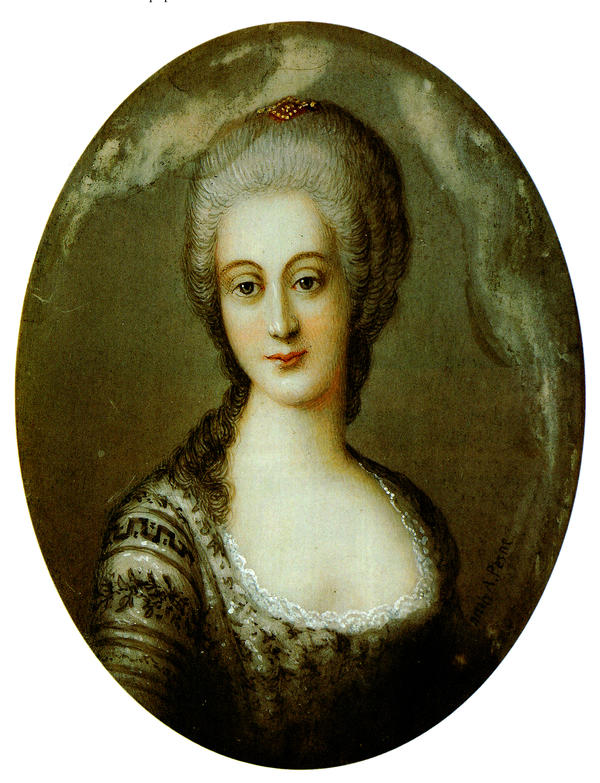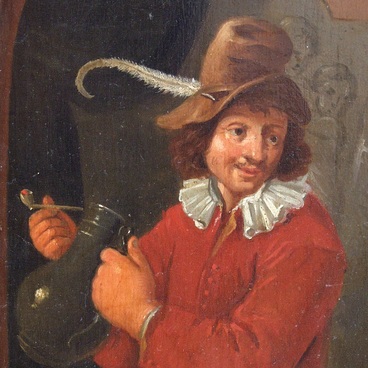The portrait of a woman from the Stavropol museum collection is a classic sample of miniature portraits in the Rococo style popular in the 18th century Europe. French artist and draughtsman Antoine Pesne created it on a thin ivory plate with water colors and ink. The image is set in a decorative oval bronze frame on a prop. The woman wears a low-cut dress of pearl grey color; her ash-blond hair is done in a high hair style with ornaments. Her noticeably rosy cheeks highlight her healthy youth, one more hallmark of the Rococo style.
Antoine Pesne was born in 1683 in Paris. He first studied art under his father Tom Pesne and later enrolled in the Royal Academy of Painting and Sculpture in Paris. His uncle, court painter of Louis the Fourteenth and Director of the Academy gave considerable assistance to the artist in his years of learning. The stipend Antoine received in 1704 to 1710 enabled him to visit Venice, Naples, and Rome. In Rome, he studied the works of Titian and Veronese, and developed his mastery of color to such perfection as to be named one of the best painters in town.
In 1711, King Frederick the First of Prussia invited young Antoine Pesne to Berlin and appointed him court painter. The artist kept that position under Frederick William the First as well. He painted multiple portraits of the royal family members and courtiers made famous by graphic interpretations manufactured by two engravers, Schmidt and Wille. Antoine painted the ceilings of the Charlottenburg palace in the vicinity of Berlin and Sanssouci in Potsdam. In 1720, Antoine Pesne was made a full member of the Royal Academy of Painting and Sculpture in Paris and two years later was appointed Director of the Berlin Academy of Arts.
Miniature portraits developed into a specific painting genre in the Renaissance period. In the 18th century, such portraits were put on tables, hung on walls, and carried in lockets. Miniatures were often used to decorate precious household items, like sniff-box lids, watch lids, ladies’ fans, etc.
A master of miniature portraits could make them as small as 1.5 cm and up to 20 cm. Such images stood out by especially delicate artwork. The artists used parchment, paper, cardboard and ivory, metal and porcelain for foundation, and watercolors, ink, gouache and oil or special decorative enamel for paints.
Antoine Pesne was born in 1683 in Paris. He first studied art under his father Tom Pesne and later enrolled in the Royal Academy of Painting and Sculpture in Paris. His uncle, court painter of Louis the Fourteenth and Director of the Academy gave considerable assistance to the artist in his years of learning. The stipend Antoine received in 1704 to 1710 enabled him to visit Venice, Naples, and Rome. In Rome, he studied the works of Titian and Veronese, and developed his mastery of color to such perfection as to be named one of the best painters in town.
In 1711, King Frederick the First of Prussia invited young Antoine Pesne to Berlin and appointed him court painter. The artist kept that position under Frederick William the First as well. He painted multiple portraits of the royal family members and courtiers made famous by graphic interpretations manufactured by two engravers, Schmidt and Wille. Antoine painted the ceilings of the Charlottenburg palace in the vicinity of Berlin and Sanssouci in Potsdam. In 1720, Antoine Pesne was made a full member of the Royal Academy of Painting and Sculpture in Paris and two years later was appointed Director of the Berlin Academy of Arts.
Miniature portraits developed into a specific painting genre in the Renaissance period. In the 18th century, such portraits were put on tables, hung on walls, and carried in lockets. Miniatures were often used to decorate precious household items, like sniff-box lids, watch lids, ladies’ fans, etc.
A master of miniature portraits could make them as small as 1.5 cm and up to 20 cm. Such images stood out by especially delicate artwork. The artists used parchment, paper, cardboard and ivory, metal and porcelain for foundation, and watercolors, ink, gouache and oil or special decorative enamel for paints.



